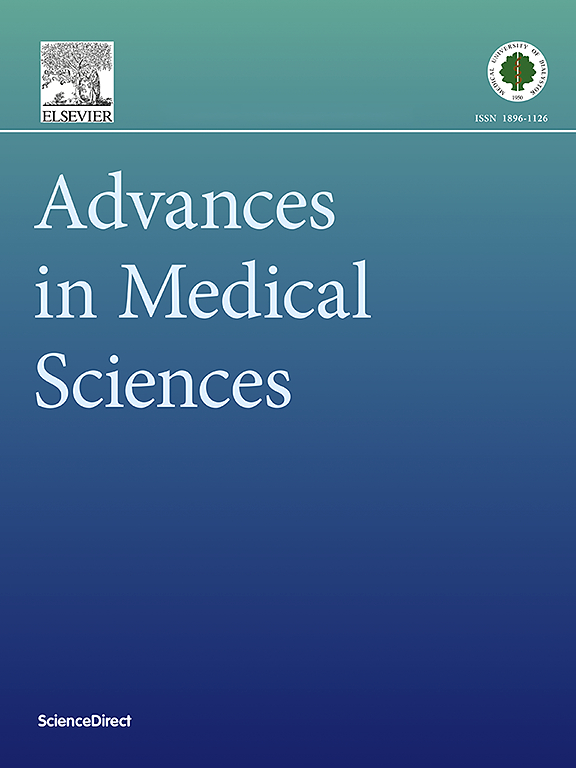Experimental evaluation of selected mechanical properties of anterior cruciate ligament and posterior cruciate ligament complex
IF 2.6
4区 医学
Q3 MEDICINE, RESEARCH & EXPERIMENTAL
引用次数: 0
Abstract
Purpose
Ligaments are fibrous connective tissues that transmit force from bone to bone. One of the most important ligaments in the human body is the knee-joint ligament, which is exposed to large and dynamic forces during daily activities. Owing to their frequent injuries, cruciate ligaments are among the most studied in the current literature. Thus far, research has focused mainly on the study of individual ligament structures and less frequently on analysing entire bone-ligament systems. Therefore, this study examines the mechanical properties of the entire cruciate ligament system.
Materials and methods
Tensile tests were conducted on 18 porcine forelimb knee joints. The joints were mounted on a holder, ensuring freedom of the ligament positioning during the examination. The test consisted of three stages: preconditioning (stage 1), relaxation (stage 2), and breaking (stage 3).
Results
In stage 1, the tissue showed a decrease in reaction force with subsequent conditioning cycles, with a slower decrease at lower tensile velocities. The dissipated energy and stiffness decreased with each cycle, but increased at higher tensile velocities. In stage 2, an increase in stiffness was observed with the elongation of the structure. In stage 3, injuries mainly occurred in the bone fragments and attachments rather than in the ligament structures.
Conclusions
The testing stage and tensile velocity influenced the mechanical response of the tissue. The obtained results are important for a better understanding of the mechanism of intra-articular periarticular injuries.
前交叉韧带和后交叉韧带复合体力学性能的实验评价。
目的:韧带是一种纤维结缔组织,在骨与骨之间传递力量。膝关节韧带是人体最重要的韧带之一,在日常活动中受到较大的动态作用力。由于其经常受伤,十字韧带是目前研究最多的文献之一。到目前为止,研究主要集中在单个韧带结构的研究上,很少分析整个骨-韧带系统。因此,本研究考察了整个交叉韧带系统的力学特性。材料与方法:对18只猪前肢膝关节进行拉伸试验。关节安装在支架上,确保检查时韧带定位的自由。测试包括三个阶段:预处理(阶段1)、放松(阶段2)和打破(阶段3)。结果:在第一阶段,组织在随后的调理周期中表现出反作用力的下降,在较低的拉伸速度下下降较慢。耗散能量和刚度随循环次数的增加而减小,但随着拉伸速度的增加而增加。在第二阶段,随着结构的伸长,刚度增加。在第3阶段,损伤主要发生在骨碎片和附着物,而不是韧带结构。结论:试验阶段和拉伸速度影响组织的力学响应。获得的结果对于更好地理解关节内关节周围损伤的机制是重要的。
本文章由计算机程序翻译,如有差异,请以英文原文为准。
求助全文
约1分钟内获得全文
求助全文
来源期刊

Advances in medical sciences
医学-医学:研究与实验
CiteScore
5.00
自引率
0.00%
发文量
53
审稿时长
25 days
期刊介绍:
Advances in Medical Sciences is an international, peer-reviewed journal that welcomes original research articles and reviews on current advances in life sciences, preclinical and clinical medicine, and related disciplines.
The Journal’s primary aim is to make every effort to contribute to progress in medical sciences. The strive is to bridge laboratory and clinical settings with cutting edge research findings and new developments.
Advances in Medical Sciences publishes articles which bring novel insights into diagnostic and molecular imaging, offering essential prior knowledge for diagnosis and treatment indispensable in all areas of medical sciences. It also publishes articles on pathological sciences giving foundation knowledge on the overall study of human diseases. Through its publications Advances in Medical Sciences also stresses the importance of pharmaceutical sciences as a rapidly and ever expanding area of research on drug design, development, action and evaluation contributing significantly to a variety of scientific disciplines.
The journal welcomes submissions from the following disciplines:
General and internal medicine,
Cancer research,
Genetics,
Endocrinology,
Gastroenterology,
Cardiology and Cardiovascular Medicine,
Immunology and Allergy,
Pathology and Forensic Medicine,
Cell and molecular Biology,
Haematology,
Biochemistry,
Clinical and Experimental Pathology.
 求助内容:
求助内容: 应助结果提醒方式:
应助结果提醒方式:


